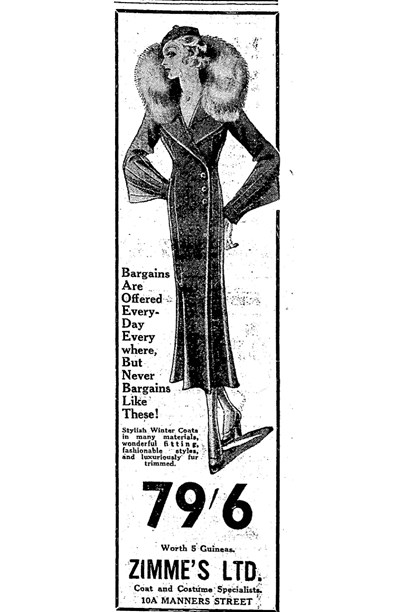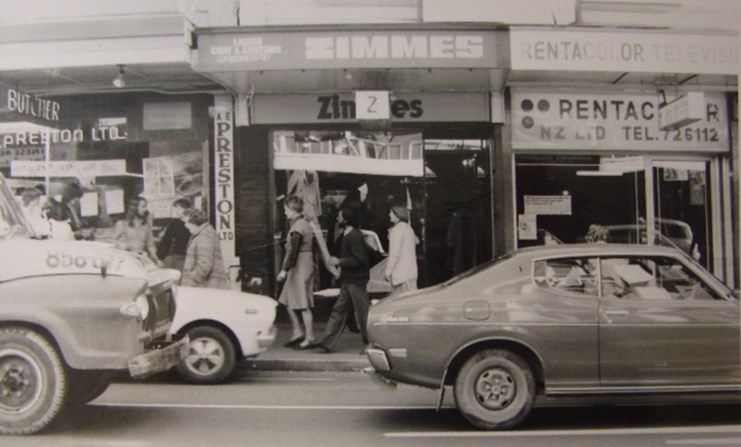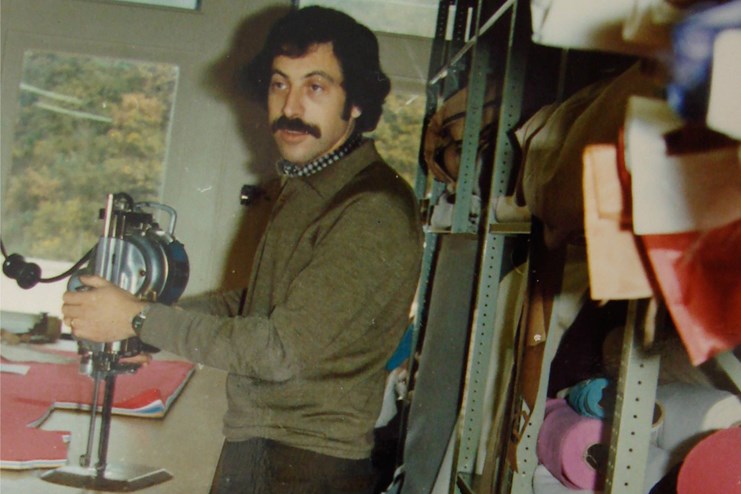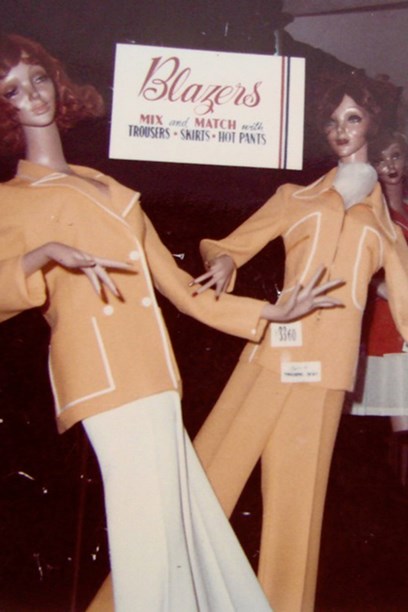Stories
Zimme's
1920s-1987

For 50 years the Zimmerman family ran a clothing retail business in the heart of Wellington. Zimme's began as a tailor shop before reinventing itself as a thriving retail store with the catchy slogan 'Where the values are'.
Miriam and Joseph Zimmerman immigrated to New Zealand from London via South Africa in the early years of the last century, eventually settling and raising a family in Wellington. Joseph spent most of his first decade in Wellington working for a ladies' tailor named Hayward's on Lambton Quay.
Joseph and Miriam established a small tailoring shop at their home at 144 Vivian Street, later moving down the road to number 86. Sometime between 1929 and 1934 they officially shortened their name to Zimme. The business was at some time referred to as Zimmies, likely an advertising error in the newspapers of the time.

Newspaper ad for Zimme's, 1934.
In the 1930s, Zimme's was located at 10A Manners Street, moving next door to number 8 in the 1940s, next to the Maple Furnishing Co. In 1942 they temporarily relocated to the McDonald's Buildings, Room 17, Floor 2, 132 Willis Street after earthquake damage to the Manners Street premises. During the late 1930s and early 1940s Miriam and Joseph had another store in Willis Street, Jane Brown.
Miriam was an astute, and by all accounts, a somewhat intimidating buyer, whilst Joseph handled the stock and special orders. After the death of Joseph in 1948, Miriam sold the business. The name languished for several years.
Two of Miriam’s daughters, Hannah and Esther, married brothers Michael and Maurice Hayvice. The brothers operated a wholesale and cut-make-and-trim factory near Zimme's, supplying the shop and a number of businesses throughout New Zealand.
In 1950 the family decided to re-open in Willis Street, retaining the name 'Zimme's'. The three Zimme sisters – Hannah, Esther and Phyllis – worked in the shop. It was situated two doors up from The Evening Post (now The Dominion Post) and the Majestic Theatre was two doors in the other direction. The Majestic was an extremely popular cinema, operated by Kerridge-Odeon, who had a distribution deal with Metro Goldwyn Mayer, amongst others. Maurice and Hannah's son, Gary Hayvice describes the scene: "If you wanted a bit of the old song and dance ‘more stars than in the heavens’ musicals, the Majestic was your number one choice. A cabaret was situated on the same floor as the box office, so on your way to the dress circle, with the mandatory box of Jaffas and maybe a double choc-top in hand, you could view the smart set in tuxedos and long dresses dancing the night away. At interval after the shorts and coming attractions there would ensue a mad rush for either a desperately needed fag or a Tip Top ice cream."
Often the patrons would wander down Willis Street and check out the shop window. This proved to be a big selling point and consequently great care was taken in having an attractive and appealing window display. There was no weekend trading so late night Fridays were always busy with customers picking up lay-bys and special orders in preparation, for a fun-filled and sartorial weekend.

Zimme's on Willis Street, 1950s.
Zimme's was a true family business with both Hannah’s and Esther’s daughters and later Esther’s granddaughter, Sheree, joining the shop. They were all superb sales girls with a discerning eye for fashion.
The early 1950s were a times of gabardine coats and suits. Gary recalls the patterns tucked away in a disused part of the factory that were heavily influenced by the seminal 1947 Dior collection. "The collection was a revelation at the time after the shortages and privations of the war years. Multiple panels, defined waists with full and often pleated skirts, wonderfully-elegant designs consuming vast amounts of material."
Gary joined Zimme's in early 1958, learning the trade and taking classes with Mrs King from Wellington Polytechnic.
The making and selling of fitted suits lasted into the early 1960s. They were virtually hand-made for eager customers by an outworker at the rate of three or four a week. Foam-backed synthetic, which required a Teflon foot for machining, and poplin raincoats were favoured later in the decade and continued to be popular through to the early 1960s.
Gary and his wife Andrea left for London in the mid-1960s. He worked in the pattern and cutting rooms of several large manufacturers, who supplied High Street chains such as Etam, Wallis and Richards Shops. The head designer would cross the Channel for the collections in Paris, sketch the latest and rush back to Clerkenwell. Within a day, samples would be ready to show to eager buyers. They generally worked off the same block for coats, another one for suits and several for dresses. Gary says it was a great time to be in London – a time of change. They flatted close to Biba in Kensington's Church Street, which they visited most Saturday mornings. Previously a grocer's, the Biba shop set the template for how fashion retailing would evolve. Very casual, inexpensive, super stock and it was always jam-packed. Barbara Hulanicki’s concept proved such a winner that she eventually set up a massive Biba store on Kensington's High Street.
When Gary returned to New Zealand, he received 60 or so patterns a year from his London contacts. "Of these possibly five would turn out to be sellers. Constantly sampling, our basic modifications were deepening the armhole, broadening the biceps and adjusting up half a size. If that sounds like Kiwi girls at the time were dairy fed weight lifters, I am sure the situation is now reversed."

Gary Hayvice in the Zimme's workroom.
The early 1970s saw the mass advent of denim usually 12 ounce or 14 ounce – coats, jackets, jerkins, dresses, jeans and skirts. "You name it, if it could be worn it was wanted in denim," Gary says. "Many were made to measure and often rather outsized. Can you imagine today walking into a chain store, being of somewhat generous proportions and requesting a jacket, skirt and jeans sized to your measurements? Maxi coats too were popular, cut in brushwool, slim fitting and single breasted. Belted raincoats were a standard as were vinyl or faux leather coats. One style in particular, single breasted with a Peter Pan collar and belted sold heaps."
The late 1970s saw the advent of the ubiquitous striped unlined pantsuit. Padded shoulders, lightly waisted and often matched with a skirt and waistcoat, cut in brown, black, navy and bottle green. During the 1970s the shop branched into dresses and separates. Most were sourced from a number of Auckland manufacturers, such as Peppertree and Society.

Window display of the pantsuit in Zimme's, 1970s.
Zimme's flourished into the 1980s. Around this time, the future Starfish designer Laurie Foon started work in the store as a retail assistant. When a construction boom began in Wellington around the middle of the decade, the Majestic Theatre and adjoining block were empty, sold to developers. Slowly this part of Willis Street became isolated.
The younger generation had shifted to Auckland, Gary's sister moved to the United States, and Gary was planning a move to Sydney. Rather than relocate he decided that it was time to end 37 wonderful years. When Zimme's closed in 1987 it was one of the last independent fashion retailers left in Wellington.
Text by Gary Hayvice and Darian Zam.
Last published December 2013.